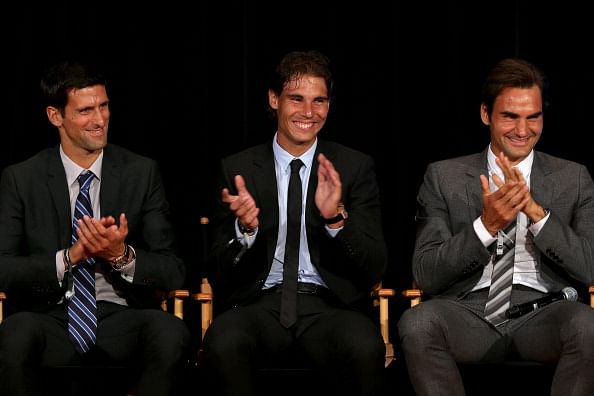
5 reasons why the Nadal-Djokovic rivalry is better than the Federer-Nadal one

As exciting as the Roger Federer vs Rafael Nadal rivalry has been ever since it unfolded for the first time exactly a decade ago, in the recent few years a shift seems to have occurred in the hierarchy of tennis rivalries. To be more precise, the Rafael Nadal vs Novak Djokovic rivlary seems to have usurped the top spot from ‘Fedal’.
This shift hasn’t come about immediately, but has rather been building up momentum slowly and gradually, as if allowing for people to get acclimatised to a new trend in men’s tennis. And while it cannot be said with absolute certainty that the Djokovic-Nadal rivalry will pip the Federer-Nadal one to go down in history as the defining rivalry of this generation, there is no doubt that at the moment, the Serb vs Spaniard battles rule the roost in the tennis world’s consciousness.
Here are five reasons why Djokovic-Nadal has eclipsed Federer-Nadal as the top rivalry in tennis, at least for the moment:
1. Close head-to-head numbers
Of the two rivalries, it’s been the Djokovic-Nadal rivalry that has been more closely fought with the Spaniard only marginally holding onto his lead in the head-to-head against the Serb. In the 43 matches they have played so far – the latest coming in the recently concluded Monte Carlo quarterfinal that Djokovic won – Nadal has won 23 times with Djokovic dogging his heels and trailing him just three matches behind, with 20 wins.
In comparison, the Federer-Nadal rivalry has been more about Nadal than about Federer, especially in recent years, with Nadal having a comfortable head-to-head record of 23 wins over Federer’s 10 victories. These irrefutable facts speak for themselves.
2. An all-encompassing rivalry
Another distinguishing factor between the two rivalries is that while Djokovic and Nadal have played against each other in almost all big tournaments, the Federer-Nadal rivalry still finds itself relatively confined to a handful of events. Federer and Nadal have never played each other at the US Open, Paris Masters, Canada Masters or the Olympics, while Nadal and Djokovic only have the Shanghai Masters missing from their list of battle venues, and even that doesn’t seem likely to be missing for much longer.
Sure, the periodic alterations in the construct and distribution of ATP events is an important factor that cannot be ignored while documenting the tournaments contested between the two sets of rivals. But even with these underlying factors, it cannot be denied that Nadal vs Djokovic is a more evenly distributed battle spanning all surfaces and conditions as compared to Federer-Nadal.
3. The age factor
The five-year age gap between Federer and Nadal meant that there was a considerable disparity in the timings of their peak periods. Though Nadal has suffered from injury setbacks, Federer’s maturity in age has played a part in shifting the advantage in Nadal’s favour with the passage of time, which can be seen in the increasingly straight-forward nature of results between the two.
But in the case of the Djokovic-Nadal rivalry, the lack of age difference (Djokovic is just one year younger than Nadal) has allowed each man to take turns dominating the other, because of which their rivalry has been thrown wide open.
4. Frequency of match-ups
Of the two sets of rivalries, in the recent couple of years, the Federer-Nadal rivalry has tapered off in volume. In 2014, they met only once, while in 2013 Federer and Nadal faced off against each other four times and in 2012, they faced each other just twice. It doesn’t help that Nadal has seen his ranking plummet recently, because of which he often ends up meeting his nemesis well before the finals.
On the other hand, Djokovic and Nadal four times in 2012 before injuries cut short Nadal’s season that year, and as many as six times in 2013. Nadal and Djokovic have faced each other mostly in summit clashes.
These are statistics that have allowed the Djokovic-Nadal rivalry to make further inroads in the minds of tennis followers as the definitive rivalry in the world.
5. Peculiarities and differences in style and game
Style of play matters, and plays an important role in setting apart any rivalry. Admittedly, the Federer-Nadal rivalry is unique in that it brings two diverse styles of play into action. But the undeniable advantage that Nadal enjoys with his lefty crosscourt forehand aimed at Federer’s backhand has made the contrast in styles into something of a powerhouse vs light-weight battle.
On the other hand, the Djokovic-Nadal rivalry is well-heeled in terms of distribution of strengths and weaknesses. It allows both players even purchase in the course of the match unlike the Federer-Nadal rivalry, which makes the strategic and tactical planning all the more important. There’s no go-to tactic that either Djokovic or Nadal can employ to achieve any kind of consistent superiority over the other, so the two players look for the tiniest of cracks in each other’s game to gain the ascendancy. That makes their match-ups thrilling and fascinating in a way that very few other rivalries are in modern tennis.